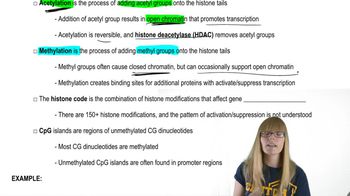Table of contents
- 1. Introduction to Genetics51m
- 2. Mendel's Laws of Inheritance3h 37m
- 3. Extensions to Mendelian Inheritance2h 41m
- 4. Genetic Mapping and Linkage2h 28m
- 5. Genetics of Bacteria and Viruses1h 21m
- 6. Chromosomal Variation1h 48m
- 7. DNA and Chromosome Structure56m
- 8. DNA Replication1h 10m
- 9. Mitosis and Meiosis1h 34m
- 10. Transcription1h 0m
- 11. Translation58m
- 12. Gene Regulation in Prokaryotes1h 19m
- 13. Gene Regulation in Eukaryotes44m
- 14. Genetic Control of Development44m
- 15. Genomes and Genomics1h 50m
- 16. Transposable Elements47m
- 17. Mutation, Repair, and Recombination1h 6m
- 18. Molecular Genetic Tools19m
- 19. Cancer Genetics29m
- 20. Quantitative Genetics1h 26m
- 21. Population Genetics50m
- 22. Evolutionary Genetics29m
13. Gene Regulation in Eukaryotes
Epigenetics, Chromatin Modifications, and Regulation
Problem 24d
Textbook Question
A particular type of anemia in humans, called β-thalassemia, results from a severe reduction or absence of the normal β-globin chain of hemoglobin. However, the γ-globin chain, normally only expressed during fetal development, can functionally substitute for β-globin. A variety of studies have explored the use of the nucleoside 5-azacytidine for the expression of γ-globin in adult patients with β-thalassemia.
How might 5-azacytidine lead to expression of γ-globin in adult patients?
 Verified step by step guidance
Verified step by step guidance1
Understand that β-thalassemia is caused by a deficiency in the β-globin chain of hemoglobin, which is crucial for oxygen transport in adults.
Recognize that γ-globin is typically expressed during fetal development and can substitute for β-globin if expressed in adults.
5-azacytidine is a nucleoside analog that can incorporate into DNA and RNA, potentially affecting gene expression.
Consider that 5-azacytidine may lead to hypomethylation of DNA, which can activate the expression of genes that are normally silenced in adults, such as the γ-globin gene.
Hypothesize that by reducing DNA methylation, 5-azacytidine could reactivate the γ-globin gene, allowing it to be expressed in adult patients, thereby compensating for the lack of β-globin.
Recommended similar problem, with video answer:
 Verified Solution
Verified SolutionThis video solution was recommended by our tutors as helpful for the problem above
Video duration:
1mPlay a video:
Was this helpful?
Key Concepts
Here are the essential concepts you must grasp in order to answer the question correctly.
β-thalassemia
β-thalassemia is a genetic blood disorder characterized by reduced or absent production of the β-globin chain of hemoglobin, leading to anemia. This condition is caused by mutations in the HBB gene, which encodes the β-globin subunit. The severity of the disease can vary, with some individuals experiencing mild symptoms while others may require regular blood transfusions.
γ-globin chain
The γ-globin chain is a component of fetal hemoglobin (HbF), which is produced during fetal development and has a higher affinity for oxygen than adult hemoglobin. In normal circumstances, γ-globin expression decreases after birth, and β-globin takes over. However, in patients with β-thalassemia, reactivating γ-globin expression can help compensate for the lack of β-globin, improving oxygen transport in the blood.
Recommended video:
Guided course

Proteins
5-azacytidine
5-azacytidine is a nucleoside analog that functions as a DNA methyltransferase inhibitor, leading to the demethylation of DNA. This process can reactivate silenced genes, including those responsible for γ-globin production. In the context of β-thalassemia, 5-azacytidine has been studied for its potential to induce the expression of γ-globin in adult patients, thereby alleviating some symptoms of the disease.






